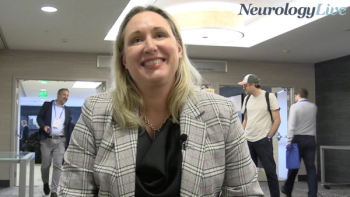
Relapse Patterns and Disease Phenotype Correlate With Treatment Change in NMOSD
Results from the CIRCLES cohort demonstrated a significant association in relapse patterns and disease phenotype for patients with NMOSD who change treatment.
Recently published in the Journal of Neurology, findings from the
Relapses, including any on-study relapse (hazard ratio [HR] = 2.91; P <.001), relapse phenotypes (HR = 2.15-5.49; P <.001), and pre-study mean annual relapse rate (ARR) more than 0.75 (HR= 2.28; P <.001) significantly correlated with the likelihood of treatment change. In addition, disease phenotype, including whether patients had brain syndrome only vs transverse myelitis (TM) involvement at onset (HR 2.44; P = .008), disease duration for less than 1 vs more than 5 years (HR 1.66; P = .028), or autoimmune comorbidity (HR 1.55; P = 0.015) correlated significantly with treatment change likelihood.
Lead author Shervin Gholizadeh, PharmD, PhD, Principal Medical Science Director at Genentech, and colleagues wrote, “While this study examined several clinical characteristics and identified relapse as a major predictor of treatment change, future studies are needed to evaluate how other factors, such as disability and quality of life, affect treatment change. It is also possible that cryptic disease activity in the absence of frank relapses, but which contributes to disability, may also benefit from approved therapeutics.”1
The longitudinal, observational study was conducted in a cohort of patients with NMOSD (n = 542) from 15 centers across North America from 2013 to 2020. Patients with more than or 60 days of follow-up and those that received on-study maintenance treatment were included, with estimations of ARR calculated through negative binomial models and treatment change through Cox proportional hazards models. Relapses as time-varying covariates estimated the relationship to treatment change.
The study had predominantly patients who were women (86.5%), White (57.4%), and seropositive for anti–aquaporin-4 (AQP4)-IgG (83.9%). During the study, 42.4% of patients received rituximab, 17.0% mycophenolate mofetil, 12.4% low-dose maintenance steroids, 11.8% azathioprine, and 0.7% tocilizumab. Disease onset phenotype that included TM or TM and brain involvement (BR) was found in 35.6% of patients, while optic neuritis (ON) or ON + BR was identified in 32.7% of the cohort. Of the total patients, 31.5% (n = 171) experienced more than or 1 relapse and 133 patients (24.5%) had more than or 1 change in the treatment regimen.
READ MORE:
The likelihood of treatment change was significantly associated with disease duration less than 1 year (HR, 1.66; 95% CI, 1.06–2.61, P = .028), autoimmune disease comorbidity (HR, 1.55; 95% CI, 1.09–2.20; P = .015), and ON and/or BR at disease onset (ON, ON + BR: 1.59 [95% CI, 1.03–2.47], P = 0.037; BR only: 2.44 [95% CI, 1.26–4.71], P = .008). Hispanic, White, and Black patients had a significantly higher mean on-study ARR than in Asian patients (0.30 vs 0.11, P = .013; 0.24 vs 0.11, P = .024; and 0.24 vs 0.11, P = .041, respectively). Notably, 6.3% (n = 20) of the cohort discontinued rituximab, thus, the probability of rituximab discontinuation in 5 years was estimated to be 24%.
Gholizadeh et al noted, “In this analysis, 90 days was set as the defined duration for all relapses; thus, relapses that started within 90 days before study consent were counted as on-study relapses. These sensitivity analyses demonstrated consistency in the relationship between on-study relapses and treatment change as compared with the 90-day definition. Thus, a relapse window spanning 90 days may represent a reasonable definition for NMOSD research assessing relapse effects.”1
Limitations of the study included only using a subset of therapies for NMOSD. Additionally, clinician judgement may have varied because of the absence of a standard definition of relapse in NMOSD. Treatment history prior to enrollment for the study was excluded from the analysis. In addition, the cohort may not be generalizable to a broader population. Another unknown from the study is if offered therapies were declined by patients and whether financial concerns played a factor in treatment change with patients.
Immunosuppressive therapy’s current focus in NMOSD is relapse rate and disease severity reduction hence, preventing relapses is critical to reduce accumulation of permanent disability.2,3 “There is a need for an endpoint that accurately measures disability in NMOSD, particularly in the absence of relapses or in between relapses. Understanding how disability affects treatment patterns may provide key insights into aiding the optimization of therapy for patients with NMOSD,” Gholizadeh et al noted.1
REFERENCES
1. Gholizadeh S, Exuzides A, Lewis KE, et al. Clinical and epidemiological correlates of treatment change in patients with NMOSD: insights from the CIRCLES cohort. J Neurol. 2022;10.1007/s00415-022-11529-6. doi:10.1007/s00415-022-11529-6
2. Kessler RA, Mealy MA, Levy M. Treatment of Neuromyelitis Optica Spectrum Disorder: Acute, Preventive, and Symptomatic. Curr Treat Options Neurol. 2016;18(1):2. doi:10.1007/s11940-015-0387-9
3. Duchow A, Paul F, Bellmann-Strobl J. Current and emerging biologics for the treatment of neuromyelitis optica spectrum disorders. Expert Opin Biol Ther. 2020;20(9):1061-1072. doi:10.1080/14712598.2020.1749259
Newsletter
Keep your finger on the pulse of neurology—subscribe to NeurologyLive for expert interviews, new data, and breakthrough treatment updates.




































